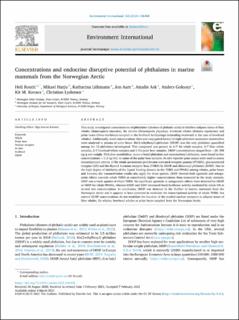| dc.contributor.author | Routti, Heli Anna Irmeli | |
| dc.contributor.author | Harju, Mikael | |
| dc.contributor.author | Lühmann, Katharina | |
| dc.contributor.author | Aars, Jon | |
| dc.contributor.author | Ask, Amalie | |
| dc.contributor.author | Goksøyr, Anders | |
| dc.contributor.author | Kovacs, Kit M. | |
| dc.contributor.author | Lydersen, Christian | |
| dc.date.accessioned | 2021-08-25T07:47:46Z | |
| dc.date.available | 2021-08-25T07:47:46Z | |
| dc.date.created | 2021-03-17T14:40:30Z | |
| dc.date.issued | 2021 | |
| dc.identifier.citation | Environment International. 2021, 152, 106458. | en_US |
| dc.identifier.issn | 0160-4120 | |
| dc.identifier.uri | https://hdl.handle.net/11250/2771084 | |
| dc.description.abstract | This study investigated concentrations of phthalates (diesters of phthalic acids) in blubber/adipose tissue of blue whales (Balaenoptera musculus), fin whales (Balaenoptera physalus), bowhead whales (Balaena mysticetus) and polar bears (Ursus maritimus) sampled in the Svalbard Archipelago (extending westward in the case of bowhead whales). Additionally, total concentrations (free and conjugated forms) of eight phthalate monoester metabolites were analysed in plasma of polar bears. Bis(2-ethylhexyl) phthalate (DEHP) was the only phthalate quantified among the 12 phthalates investigated. This compound was present in 6/7 fin whale samples, 4/7 blue whale samples, 2/5 bowhead whale samples and 1/12 polar bear samples. DEHP concentrations ranged from <20–398 ng/g wet weight. Phthalate metabolites, mono-n-butyl phthalate and monoisobutyl phthalate, were found in low concentrations (<1.2 ng/mL) in some of the polar bear samples. In vitro reporter gene assays were used to assess transcriptional activity of fin whale peroxisome proliferator-activated receptor gamma (PPARG), glucocorticoid receptor (GR) and the thyroid hormone receptor beta (THRB) by DEHP and diisononyl phthalate (DiNP). Due to the high degree of similarity of the ligand binding domain in the THRB and PPARG among whales, polar bears and humans, the transactivation results also apply for these species. DEHP showed both agonistic and antagonistic effects towards whale THRB at considerably higher concentrations than measured in the study animals; DiNP was a weak agonist of whale THRB. No significant agonistic or antagonistic effects were detected for DEHP or DiNP for whale PPARG, whereas DEHP and DiNP decreased basal luciferase activity mediated by whale GR at several test concentrations. In conclusion, DEHP was detected in the blubber of marine mammals from the Norwegian Arctic and it appears to have potential to modulate the transcriptional activity of whale THRB, but current DEHP concentrations do not modulate the function of the studied nuclear receptors in adipose tissue of blue whales, fin whales, bowhead whales or polar bears sampled from the Norwegian Arctic. | en_US |
| dc.language.iso | eng | en_US |
| dc.rights | Navngivelse 4.0 Internasjonal | * |
| dc.rights.uri | http://creativecommons.org/licenses/by/4.0/deed.no | * |
| dc.title | Concentrations and endocrine disruptive potential of phthalates in marine mammals from the Norwegian Arctic | en_US |
| dc.type | Peer reviewed | en_US |
| dc.type | Journal article | en_US |
| dc.description.version | publishedVersion | en_US |
| dc.rights.holder | © 2021 The Authors. Published by Elsevier Ltd. | en_US |
| dc.source.volume | 152 | en_US |
| dc.source.journal | Environment International | en_US |
| dc.identifier.doi | 10.1016/j.envint.2021.106458 | |
| dc.identifier.cristin | 1898715 | |
| dc.relation.project | Norges forskningsråd: 244488 | en_US |
| dc.source.articlenumber | 106458 | en_US |
| cristin.ispublished | true | |
| cristin.fulltext | original | |
| cristin.qualitycode | 1 | |

